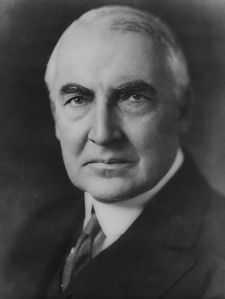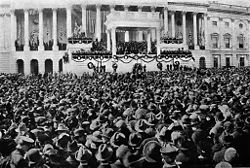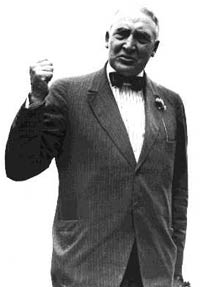Warren G. Harding
| Term of office | March 4, 1921 – August 2, 1923 |
| Preceded by | Woodrow Wilson |
| Succeeded by | Calvin Coolidge |
| Date of birth | November 2, 1865 |
| Place of birth | Near Blooming Grove, Ohio |
| Date of death | August 2, 1923 |
| Place of death | San Francisco, California |
| Spouse | Florence Kling Harding |
| Political party | Republican |
Warren Gamaliel Harding (November 2, 1865 – August 2, 1923) was the twenty-ninth President of the United States, serving from 1921 to 1923, his term ending when he died from a heart attack at 57. A Republican from Ohio, Harding was an influential newspaper publisher. He served in the Ohio Senate (1899–1903), later as Lieutenant Governor of Ohio (1903–1905) and as a U.S. Senator (1915–1921).
His political leanings were conservative, which enabled him to become the compromise choice at the 1920 Republican national convention. During his presidential campaign, held in the aftermath of World War I, he promised a return to "normalcy"; and, in the 1920 election, he defeated his Democratic opponent, fellow Ohioan James M. Cox, by a landslide—60 percent to 34 percent.
Harding headed a cabinet of notable men such as Charles Evans Hughes, Andrew Mellon, Herbert Hoover and Secretary of the Interior Albert B. Fall, who was jailed for his involvement in the Teapot Dome scandal. In foreign affairs, Harding signed peace treaties that built on the Treaty of Versailles, which formally ended World War I. He also led the way to world naval disarmament at the Washington Naval Conference of 1921–1922.
By many, Harding is ranked as one of the least successful U.S. presidents, despite having been immensely popular while in office. He was an affable yet calm, reserved, and internally focused man, with a strong sense of humility, fair play, and patriotism. Although a skillful and dedicated politician, he was limited more by his conception of his office, rather than ability. It was a time of belief in limited government, long-shared by most Americans. His record as president likely deserves more respect than the dismissals that persist to the present day.
Early life
Harding was born on November 2, 1865, near Blooming Grove, Ohio. He was the eldest of the eight children of Dr. George Harding and Phoebe Dickerson Harding. Among his boyhood heroes he numbered Alexander Hamilton and Napoleon. His mother was a midwife who later obtained her medical license, and his father taught for a time at a rural school north of Mount Gilead, Ohio. During his teenage years, the Harding family moved to Caledonia, Ohio in neighboring Marion County, Ohio when Harding's father acquired The Argus, a local weekly newspaper. It was here that Harding learned the basics of the newspaper business. Harding's education was completed at Ohio Central College in Iberia, Ohio. While a college student, he learned about the printing and newspaper trade while working at the Union Register in Mount Gilead.
After graduation, Harding moved to Marion, Ohio, where he raised $300 with two friends to purchase the failing Marion Daily Star. It was the weakest of Marion's three newspapers and the only daily in the growing city. Harding converted the paper's editorial platform to support the Republicans and enjoyed a moderate degree of success. However, Harding's political stance was at odds with those who controlled most of Marion's local politics. When Harding moved to unseat the Marion Independent as the official paper of record, his actions brought the wrath of one of Marion's wealthiest real estate speculators, Amos Kling, down upon him.
While Harding won the war of words and made the Marion Daily Star one of the biggest newspapers in the county, the battle took a toll on his health. In 1889, when Harding was 24, he suffered from exhaustion and nervous fatigue. He traveled to Battle Creek, Michigan, to spend several weeks in a sanatorium regaining his strength. The treatment there was based on the health principles advocated by the Seventh-day Adventist Church.
He later returned to Marion to continue operating the paper. He spent his days boosting the community on the editorial pages, and his evenings "bloviating." Although "bloviate" is listed slang dictionaries from as far back as the nineteenth century, Harding popularized the term in the 1920s. Famed for his poor English usage, Harding often used the word to describe his own long-winded speaking style. The term dropped from popular usage following his presidency, but was resurrected in the 1960s when it was sometimes used in reference to Harding.
In 1891 Harding married Florence Kling, who was the mother of a young son. Florence's father, Amos Kling, had remained Harding's nemesis. Upon hearing that his only daughter intended to marry Harding, Kling disowned her and even forbade his wife to attend her wedding. He opposed the marriage vigorously and would not speak to his daughter or son-in-law for the next eight years.
The couple complemented one another. Harding's affable personality balanced his wife's no-nonsense approach to life. Florence Harding had inherited her father's determination and business sense and turned the Marion Daily Star into a profitable business. She has been credited with helping Harding to achieve greater things than he could have done alone, leading to speculation that she later pushed him all the way to the White House.
Harding was a Freemason, raised to the Sublime Degree of a Master Mason on August 27, 1920, in Marion Lodge #70, F.& A.M., in Marion, Ohio.
Political rise
As an influential newspaper publisher with a flair for public speaking, Harding was elected to the Ohio State Senate in 1899. He served four years before being elected lieutenant governor of Ohio, a post he occupied from 1903 to 1905. His leanings were conservative, and his record in both offices was relatively undistinguished. At the conclusion of his term as lieutenant governor, Harding returned to private life.
Senator
Re-entering politics five years later, Harding lost a race for governor in 1910 but won election to the United States Senate in 1914. He served in the Senate from 1915 until his inauguration as president on March 4, 1921, becoming the second sitting senator to be elected President of the United States.
As with his first term as senator, Harding had a relatively undistinguished record, missing over two-thirds of the roll-call votes. Among them was the vote to send the Nineteenth Amendment (granting women's suffrage) to the states for ratification, a measure he had supported. Harding was a strong opponent of President Woodrow Wilson's proposal to create a League of Nations, and he made a speech against its formation, claiming it was a mockery of American democracy.
Election of 1920
In the 1920 election, Harding ran against Democratic Ohio Governor James M. Cox, whose vice presidential candidate was Assistant Secretary of the Navy Franklin D. Roosevelt. The election was seen in part as a referendum on whether to continue with the “progressive” work of the Woodrow Wilson administration or to revert to the “laissez-faire” approach of the President William McKinley era.
Harding ran on a promise to “Return to Normalcy,” a term he coined which reflected three trends of his time: a renewed isolationism in reaction to World War I, a resurgence of nativism, (the revival of indigenous culture as opposed to acculturation), and a turning away from the government activism of the reform era.
Harding's “front porch campaign” during the late summer and fall of 1920 captured the imagination of the country. Not only was it the first campaign to be heavily covered by the press and receive widespread newsreel coverage, but it was also the first modern campaign to use the power of Hollywood and Broadway stars who traveled to Marion for photo opportunities with Harding and his wife. Al Jolson, Lillian Russell, Douglas Fairbanks, and Mary Pickford were among the conservative-minded luminaries to make the pilgrimage to central Ohio. Business icons Thomas Edison, Henry Ford, and Harvey Firestone also lent their cachet to the campaign. From the onset of the campaign until the November election, over 600,000 people traveled to Marion to participate.
The campaign owed a great deal to Florence Harding, who played perhaps a more active role than any previous candidate's wife in a presidential race. She cultivated the relationship between the campaign and the press. As the business manager of the Star, she understood reporters and their industry and played to their needs by making herself freely available to answer questions, pose for pictures, or deliver food prepared in her kitchen to the press office, which was a bungalow she had constructed at the rear of their property in Marion. Mrs. Harding even went so far as to coach her husband on the proper way to wave to newsreel cameras to make the most of coverage.
The campaign also drew upon Harding's popularity with women. Considered handsome, Harding photographed well in contrast to his opponent Cox. However, it was Harding's support for women's suffrage in the Senate that made him extremely popular with women: the ratification of the Nineteenth Amendment in August 1920 brought huge crowds of women to Marion, Ohio to hear Harding.
The milestone election of 1920 was the first in which women could vote nationwide. Harding received 61 percent of the national vote and 404 electoral votes, an unprecedented margin of victory. Cox received 36 percent of the national vote and 127 electoral votes. Socialist Eugene V. Debs, campaigning from federal prison, received 3 percent of the national vote. Debs was in prison for opposing Wilson's draft; despite the many political differences between the two candidates, when Harding became president he pardoned Debs.
Presidency 1921–1923
The administration of Warren G. Harding followed the Republican Party platform approved at the 1920 Chicago convention. The thrust of the administration was to return the nation to a period in time when business force—not government watchdog agencies—minded the business of the nation.
Harding also believed in the clear separation of powers; that it was the Congress that was responsible for legislation, and it was Harding’s duty to ensure that it was signed into law. Harding also held high regard for the U.S. Supreme Court and believed that the Court’s role was to act as a safety net for Constitutional matters on behalf of the nation, its interests and most importantly, its citizens. To solidify that notion, he nominated President William Howard Taft for the position of Chief Justice.
During his term, Harding personally answered most of the correspondence sent to him, which included queries posed to the president from United States citizens. It wasn’t until his health began to decline in 1923 that he turned the correspondence over to a staff of assistants.
Harding also pushed for the establishment of the Bureau of Veterans Affairs, the first permanent attempt at answering the needs of those who had served the nation in times of war. Both President and Mrs. Harding visited with members of the armed services who were hospitalized.
Harding also undertook a very active speaking schedule. In October 1921, in Birmingham, Alabama, Harding spoke out in favor of thoughtfully approaching the issue of race, stating that the nation could not enjoy the promises of prosperity until the matter of equality was addressed.
Events during Harding’s presidency
- Peace treaties signed with Germany, Austria and Hungary, formally ending World War I for the United States
- Established the Bureau of Veteran Affairs
- Treaty to indemnify Colombia for its loss of Panama
- Washington Naval Conference, 1921-1922
- Budget and Accounting Act, 1921
- Revenue Act of 1921, which reduced taxes that had been increased to fund World War I
- Fordney-McCumber Tariff, 1922
- Teapot Dome Scandal involving the transfer oil fields in Wyoming reserved for the U.S. Naval Department
- Resignation of Harding's attorney general for accepting bribes
Administration and Cabinet
| OFFICE | NAME | TERM |
| President | Warren G. Harding | 1921–1923 |
| Vice President | Calvin Coolidge | 1921–1923 |
| Secretary of State | Charles Evans Hughes | 1921–1923 |
| Secretary of the Treasury | Andrew Mellon | 1921–1923 |
| Secretary of War | John W. Weeks | 1921–1923 |
| Attorney General | Harry M. Daugherty | 1921–1923 |
| Postmaster General | Will H. Hays | 1921–1922 |
| Hubert Work | 1922–1923 | |
| Harry S. New | 1923 | |
| Secretary of the Navy | Edwin Denby | 1921–1923 |
| Secretary of the Interior | Albert B. Fall | 1921–1923 |
| Hubert Work | 1923 | |
| Secretary of Agriculture | Henry C. Wallace | 1921–1923 |
| Secretary of Commerce | Herbert Hoover | 1921–1923 |
| Secretary of Labor | James J. Davis | 1921–1923 |
Supreme Court appointments
Harding appointed the following justices to the Supreme Court of the United States:
- William Howard Taft - Chief Justice - 1921 (Harding was the only president to have appointed a previous president to the Supreme Court.)
- George Sutherland - 1922
- Pierce Butler - 1923
- Edward Terry Sanford - 1923
Administrative Scandals
As many presidents before and after him, he had to deal with corruption within his administration. Veterans Bureau director Charles Forbes was convicted and jailed for financial dishonesty in the building of hospitals. The full story came to light only after Harding’s death, but the president knew enough to quickly and responsibly request Forbes’s resignation on learning of his misdeeds.
One of his former cabinet members, Albert B. Fall was later convicted of accepting a bribe to lease naval oil reserves at Teapot Dome, Wyoming, and Elk Hills, California, to oil entrepreneurs, and was sent to prison—the first, but not last, former cabinet member to be sent to prison.
No evidence to date suggests that Harding personally profited from these crimes, but he was apparently unable to stop them. Harding’s death in 1923 prevented him from defending himself from personal and political attacks.
Death in office
At the end of July, while traveling south from Alaska through British Columbia, he developed what was thought to be a severe case of food poisoning. Arriving at the Palace Hotel in San Francisco, he developed pneumonia. Harding died of either a heart attack or a stroke at 7:35 P.M. on August 2, 1923, at the age of 57.
Naval physicians surmised that he had suffered a heart attack; however, Dr. Charles Sawyer, the surgeon general, who was traveling with the presidential party, did not make this diagnosis. Upon Sawyer's recommendation, Mrs. Harding refused permission for an autopsy, which soon led to speculation that the president had been the victim of a plot. Vice President Calvin Coolidge, who was sworn in by his father, a justice of the peace, in Plymouth Notch, Vermont, succeeded Harding.
Following his death, Harding's body was returned to Washington, D.C., where it was placed in the East Room of the White House pending a state funeral at the United States Capitol. White House employees at the time were quoted as saying that the night before the funeral, they heard Mrs. Harding speak for more than an hour to her dead husband. The most commonly reported remark attributed to Mrs. Harding at this time was “They can't hurt you now, Warren.”
Harding was entombed in Marion Cemetery, Marion, Ohio, in August 1923. Following Mrs. Harding's death on November 21, 1924, she too was temporarily buried next to her husband. Both bodies were moved in December 1927 to the newly completed Harding Memorial in Marion, which was dedicated by President Herbert Hoover in 1931.
Memorials
- Harding Memorial, Marion, Ohio. [1]
- Harding County, New Mexico, is named in his honor.
- Harding Park Golf Club in San Francisco is named after him.
Trivia
- Harding is the only U.S. president to be elected on his birthday, November 2 (it was his fifty-fifth).
- The 1920 presidential election was the only presidential election in which the two major party nominees were office holders from the same state and had the same profession. Both men were from Ohio and were newspaper publishers.
- Harding was the first U.S. president to ride to his inauguration in an automobile.
- Harding was the first U.S. president to speak on the radio and have one in the White House.
- He was the first U.S. president born after the end of the American Civil War.
ReferencesISBN links support NWE through referral fees
- "Social Equality Impossible for Negro, Says President, Pleading for Fair Treatment," Atlanta-Journal Constitution, October 27, 1921.
- "An International Problem," Marion Daily Star, October 26, 1921.
External links
All links retrieved May 3, 2023.
- Inaugural Address
- First State of the Union Address of Warren Harding, December 6, 1921
- Second State of the Union Address of Warren Harding
- C-Span The American Presidents
| Preceded by: Harry L. Gordon |
Lieutenant Governor of Ohio 1904–1906 |
Succeeded by: Francis W. Treadway |
| Preceded by: Theodore E. Burton |
United States Senator (Class 3) from Ohio 1915–1921 |
Succeeded by: Frank B. Willis |
Credits
New World Encyclopedia writers and editors rewrote and completed the Wikipedia article in accordance with New World Encyclopedia standards. This article abides by terms of the Creative Commons CC-by-sa 3.0 License (CC-by-sa), which may be used and disseminated with proper attribution. Credit is due under the terms of this license that can reference both the New World Encyclopedia contributors and the selfless volunteer contributors of the Wikimedia Foundation. To cite this article click here for a list of acceptable citing formats.The history of earlier contributions by wikipedians is accessible to researchers here:
The history of this article since it was imported to New World Encyclopedia:
Note: Some restrictions may apply to use of individual images which are separately licensed.


